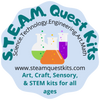
In the push to prepare students for a technology-driven future, STEM—Science, Technology, Engineering, and Mathematics—has become a focal point in education. However, there’s growing recognition that something is missing from this equation: the creative power of Art. Integrating Art into STEM transforms the framework into S.T.E.A.M., an approach that recognizes the value of creativity and innovation in problem-solving.
Why Art Belongs in STEM
1. Art Sparks Creativity in Problem-Solving
STEM subjects require logical thinking and analytical skills, but innovation often stems from creative thinking. Artistic practices—like drawing, designing, or storytelling—help students approach challenges from new perspectives. For instance, engineering a sustainable city requires not only technical precision but also creative vision to design spaces that are both functional and beautiful.
2. Visualizing Complex Concepts
Art is a powerful tool for making abstract STEM concepts more tangible. Data visualization, diagrams, and models translate complex information into digestible, visual formats. Whether it’s illustrating the molecular structure of a compound or designing a user interface for an app, art makes STEM concepts accessible and engaging.
3. Art Humanizes Technology
The rapid rise of technology demands products and systems that resonate with people. Design thinking—a process that relies heavily on empathy and creativity—is critical in developing user-friendly technology. For example, creating a medical device isn’t just about its functionality; it’s about ensuring it’s intuitive and comfortable for patients to use.
4. Enhancing Communication Skills
Art fosters storytelling, a key skill in communicating STEM ideas. Scientists and engineers often struggle to convey their ideas to non-experts. Through art, they can create compelling presentations, infographics, and visual narratives that bring their discoveries to life.
Incorporating Art into STEM doesn’t dilute the rigor of science or math; instead, it amplifies the potential for innovation and discovery. Art challenges us to think beyond the confines of data and formulas, inviting imagination to lead the way. By embracing S.T.E.A.M., we’re preparing students not just to work in a world of automation and algorithms, but to create it.

